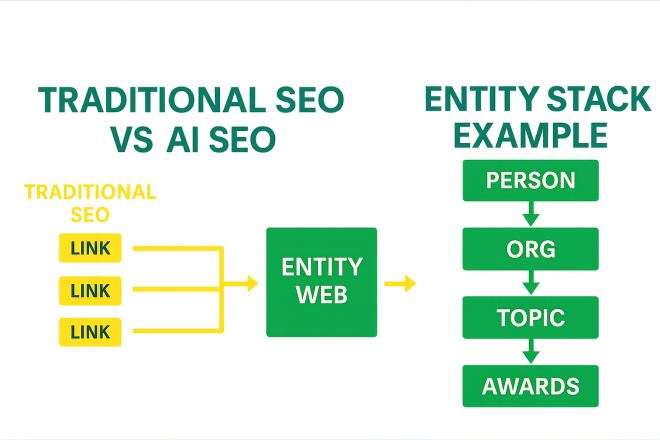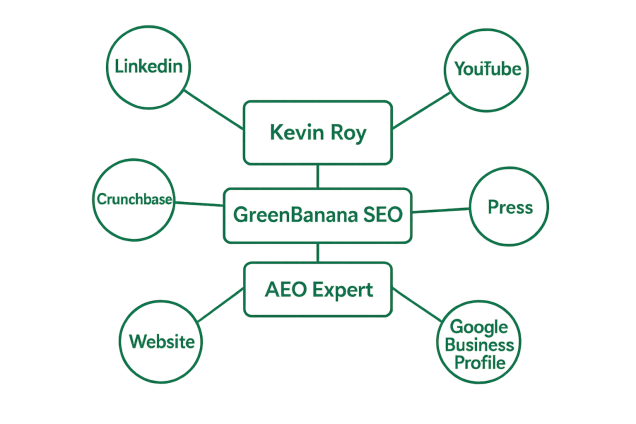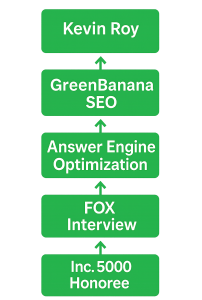AI search engines don’t evaluate content the same way Google’s algorithm does.
Where traditional SEO focused on backlinks, keywords, and on-page structure, today’s AI engines — ChatGPT, Gemini, Perplexity, Claude — evaluate people, organizations, and the relationships between them.
This shift has created one of the most critical new ranking levers in Answer Engine Optimization: Entity Stacking.
If your content, your author identity, and your organization show up consistently across the web, AI systems trust you more — and that trust leads to greater visibility inside AI-generated answers.
For the full walkthrough, graphics, and video breakdown, watch the episode here:
What Is Entity Stacking?
Entity Stacking is the practice of reinforcing the relationships that define who you are, what you do, and why you’re credible.
Instead of thinking in terms of backlinks alone, Entity Stacking considers connections like:
-
Person → Organization
-
Person → Topic/Expertise
-
Organization → Industry
-
Person → Press Coverage
-
Organization → Location
-
Person → Awards / Recognition
These relationships already exist — you’re simply making them clear, consistent, and machine-readable across your digital ecosystem.
When AI systems see the same facts repeated across your website, LinkedIn, press mentions, schema, business listings, and directory profiles, those signals form a trust cluster.
And trust is what drives visibility in AI answers.
Why AI Uses Entity Relationships
AI engines don’t just scan your content. They evaluate:
-
Who wrote it
-
Where that person works
-
What they’re known for
-
Where else do they appear online
-
How consistently those facts show up
Whether respected sources verify them
Instead of page-level authority, AI looks for entity-level confidence.
If the model sees:
“Kevin Roy → GreenBanana SEO → AEO → Forbes → Inc. 5000 → LinkedIn → Author Page”
…it’s receiving multiple independent signals confirming the same identity.
The result:
AI can safely cite you.
Backlinks Still Matter — But They’re Not Enough
Backlinks act as introductions.
Entity Stacking is reputation consistency.
A backlink tells AI, “this person or brand is referenced.”
An entity stack tells AI, “This information is verified.”
 When you combine:
When you combine:
-
Strong backlinks
-
Structured schema
-
Consistent bios
-
Press mentions
-
Author-identified content
-
Interlinked pages on your site
-
Verified profiles across the web
…you create an airtight identity graph.
This is exactly what AI wants to see before pulling you into a recommendation, answer, or citation.
How to Build Your Entity Stack
You can begin strengthening your entity graph with a few simple steps:
1. Connect your Person + Organization schema
Link your author entity to your business, your expertise, and your social profiles.
2. Align your messaging across every platform
Your About page, LinkedIn bio, press quotes, and social media should all match.
3. Earn high-trust backlinks that reference both you and your company
Press, podcasts, interviews, associations, and speaking credits work best.
4. Publish content with a clear, consistent author identity
Use bylines, author schema, and your author page to anchor everything.
5. Internally link your service pages and educational content to your author page
This strengthens your on-site identity graph.
Why This Matters for AI Visibility
When ChatGPT, Gemini, and Perplexity generate answers, they rely on content backed by verified humans and verified organizations.
Entity Stacking makes you a safer, more trustworthy source.
The result?
More citations.
More visibility.
More authority in AI.
For a full breakdown of how this works — including the analogies, examples, and step-by-step process — watch the complete video here:
👉 https://greenbananaseo.com/ai-search-videos/entity-stacking/
![]() Watch this Video about Author Identity on our AI Ranking YouTube Channel!
Watch this Video about Author Identity on our AI Ranking YouTube Channel!
Author Identity: The Foundation of AEO
Your author presence doesn’t just strengthen trust — it’s the foundation of Answer Engine Optimization (AEO). AI search engines like ChatGPT, Gemini, and Perplexity reward credible entities that consistently demonstrate expertise and authenticity. When your author data is verified and structured, you’re signaling to AI that your content belongs in authoritative results.
Boosting Visibility in ChatGPT
Optimizing for AI visibility starts where most conversations now happen — inside ChatGPT. Through our ChatGPT SEO Agency Services, we help brands ensure their insights, schema, and entities are understood and cited by OpenAI’s ecosystem. If you want your content to appear inside ChatGPT’s answers, building a consistent author identity is step one.
Strengthening Your Authority in Gemini
Google’s Gemini uses its own retrieval and reasoning system to surface high-trust content. That’s why our Gemini SEO Agency Services focus on aligning your site’s topical clusters and author signals with Google’s evolving AI ranking logic. A verified author identity helps Gemini connect your content with your expertise — giving your brand greater visibility across search and AI results.
Expanding Reach in Perplexity
Perplexity.ai combines citation-based retrieval with contextual ranking, making author credibility more important than ever. Our Perplexity SEO Agency Services are designed to position your content for visibility in AI summaries and direct-source citations — where real audience trust is built.
How to Implement Author Schema
To make your author identity machine-readable, you’ll need to implement Author using structured data. This connects your name, role, and verified links (like LinkedIn or media mentions) directly to your published content. Schema helps AI engines understand who you are — and that your expertise is worth citing.
Here is a link to My Author Schema



